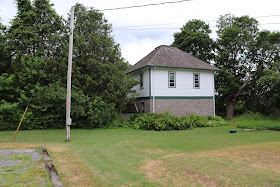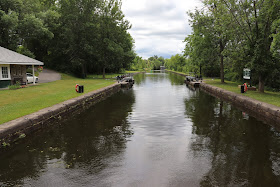This defensible lockmaster's house, designed by Royal Engineers and built in association with the Lower Nicholsons lock station in the second quarter of the nineteenth century is now a private residence. The Government of Canada recognized it as a Federal Heritage Building on April 30, 1992.
 |
| Parks Canada Rideau Canal National Historic Site of Canada Lower Nicholsons Lock Parcs Canada Canal-Rideau Lieu historique national du Canada Écluse de Lower Nicholsons |
NICHOLSONS
The two locks at this station are separated by one of the few stretches of artificial channel on the Rideau Waterway. Colonel John By frequently followed the route of lakes and rivers to avoid the costly excavation through rock and heavily-wooded terrain. Here, however, the Rideau River is obstructed by a series of rapids which you can see if you walk a few hundred yards west along the road crossing the upper lock. Because of these rapids, Colonel By had to abandon the river route and cut a straight channel a quarter mile long through the bank. On the hill overlooking the locks is the defensible lockmaster's house built in 1838 to protect the station in case of possible invasion. Fortunately it was never needed for this purpose and during the 19th century served a more peaceful use as the home of the lockmaster and his family.
Between 1826 and 1832, an old Indian canoe route along the Rideau and Cataraqui Rivers was transformed at the command of the British government from untamed wilderness rivers into the Rideau Canal. The purpose of this remarkable artery was to provide the British army with a safe route for supplying its inland garrisons, avoiding the direct but exposed route along the St. Lawrence, which only the disorganization of the American forces had prevented from being cut during the War of 1812.
The 202 km (126 miles) of waterway was made navigable by 47 locks grouped in 24 stations with their associated dams and weirs. The word was designed and superintended by the Royal Engineers, commanded by Lieutenant Colonel John By; the actual construction was done by local contractors.
Despite the blockhouses along the waterway, the role of the Rideau has always been peaceful. It was a busy waterway, carrying settlers and supplies into the growing settlement of the interior intul the middle of the 19th century, when larger locks were opened on the St. Lawrence. At the same time, since the possibility of war between Britain and the United States was now unlikely, the British Board of Ordnance signed the system over to the colonial government of Canada in 1856. The period of the Canal's military administration was over.
Local commercial traffic remained important until the advent of the automobile and better roads about the time of World War 1. Since that time recreational boating has grown steadily so that now the system, well into its second century, is busier than ever.
NICHOLSONS
Les deux écluses de ce poste sont séparées par l'un des rares tronçons artificiels du canal Rideau. Pour construire le canal, le colonel John By a souvent pu suivre les lacs et les rivières et éviter ainsi de coûteux travaux d'excavation dans des terrains rocheux et densément boisés. Ici, toutefois, le Canal Rideau est entrecoupé de rapides que vous apercevrez en avançant de quelques centaines de mètres à l'ouest, sur la route qui enjambe l'écluse supérieure. À cause ces rapides, le colonel By a dû cesser de suivre la rivière et creuser un canal de quelque 400 mètres sur la berge. Sur la colline qui surplombe les environs se trouve la maison fortifiée du maître-éclusier construite en 1938 pour asurer la défense de l'écluse. Heureusement, elle n'a jamais été utilisée à cette fin et au cours du XIXe siècle, elle a davantage servi de résidence au maître-éclusier et à sa famille.
Entre 1826 et 1832, une ancienne voie d'eau utilisée par les Indiens le long des rivières Rideau et Cataraqui fut transformée à la demande du gouvernement britannique en un réseau de voies navagables : le canal Rideau. Le but de cet ouvrage remarquable était de fournir à l'armée britannique une route sûre pour approvisionner ses garnisons. On évitait ainsi le Saint-Laurent, voie plus directe mais oussi plus dangereuse qui n'était demeurée ouverte qu'en raison de la désorganisation de l'armée américaine au cours de la guerre de 1812.
Le réseau de 202 km (126 milles) a été rendu navigable par la construction de 47 écluses regroupées en 24 postes. Les travaux ont été planifiés et surveillés par les Royal Engineers. Sous le commandement du lieutenant-colonel John By. Ils ont été exécutés par des entrepreneurs locaux.
Malgré les blockhaus qui se trouvent le long du réseau, le Rideau n'a jamais été troublé par la guerre. Ce fut un cours d'eau achalandé transportant colons et approvisionnement à l'intérieur des terres jusq'au milieu de XIXe siècle lorsque les grandes écluses du Saint-Laurent furent ouvertes à la navigation. Au même moment, la menace de guerre entre la Grande-Bretagne et les États-Unis s'étant estompée, le British Board of Ordnance céda le réseau au gouvernement colonial du Canada en 1856. Ceal mit fin à l'administration militaire du canal.
Le trafic commercial local demeura important jusqu'à l'apparition de l'automobile et la construction de meilleurs routes à l'époque de la Première Guerre mondiale. Depuis, les plaisanciers se sont faits de plus en plus nombreux, tant et si bien qu le réseau, qui en est à son deuxième siècle d'existence, et maintenant plus fréquenté que jamais.
















































